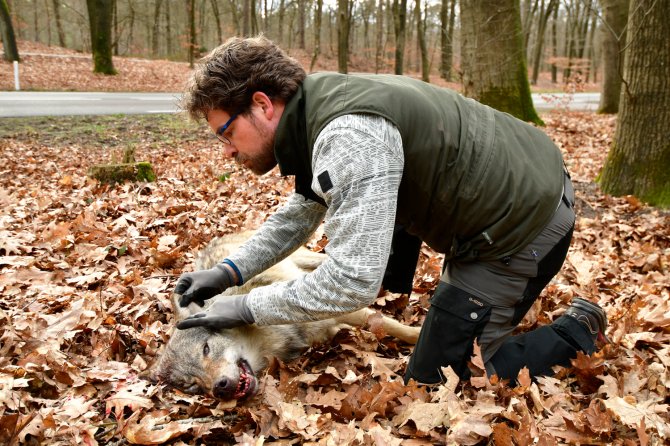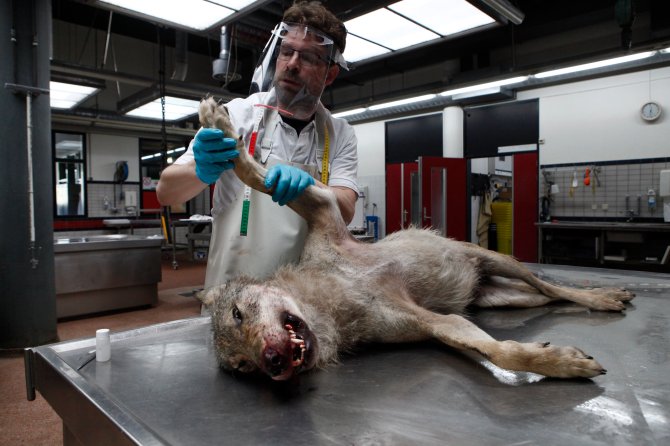
Interview
The wolf can teach man a great deal
Of all the animals, the wolf is the most like man. It is a family animal, they live with father, mother, children of this year and the previous year, uncles, aunts ... The social content of the wolf is very high. Young are always allowed to return to the nest, even if they have been away for a while. Not all wolves reproduce, only if you have a good partner and the bond is in order there will be young. But everyone is responsible for the care of the children. There is leadership, hierarchy and at the same time you see that they are individuals. This comes out very clearly in the research: they are not the extremely shy animals as we had thought, they have their own character. Just like the dogs we keep as pets. It's fascinating'. For ecologist Hugh Jansman it is clear: man can learn something from the wolf. Last week he published the report "The wolf back in the Netherlands, a fact-finding study" that was made under his supervision.
Unique situation
The report is the basis for the revisions of the inter-provincial wolf plan, which should be ready in the course of next year. At the same time, there is also a lot of interest from abroad in the findings of Jansman and his colleagues. "We are in a unique situation, researchers from across Europe are watching how things are going in our country. The wolf has re-established itself in the Netherlands; never before has the animal returned to a country where the population density is so high and where there is so much livestock density as in ours. The task that the policy now has is: how are we going to do that. Emotions are high when it comes to the wolf so how do you make sure they can coexist, Jansman says. With this report all the facts are in a row and emotions can be substantiated with knowledge. I hope that it will remove a lot of ignorance. The wolf is an ordinary species that can have a great existence in our country.
DNA research
Jansman received a phone call the day before that a wolf had been killed on the Veluwe, near Stroe. 'It is a young adult male. Genetic research has to find out who he is. Whether it's a wolf we know or a wolf found in the Netherlands for the first time. That is also possible. We can now determine this fairly precisely through DNA research,' explains the researcher. But we'll have to wait a little longer for that, because DNA research is done once every quarter. We can then examine 96 samples at once.' In the report, the movements of about six illustrative wolves are described in detail.

Where they walked and lived, what they ate, whether any damage was caused to livestock and under what circumstances. 'That part of the study gave us a lot of new insights,' Jansman says. 'For example, you can see that a wolf first roams through a larger area and eventually chooses a much smaller territory to live in. They orient themselves first, you could say'. If you know where the wolf has settled, then its territory is about 200 km2 in size. As a livestock farmer you then know that a visit from a wolf is foreseeable and that you had better take measures to protect your livestock. A wolf can learn very well to stay away from livestock, a fence with electricity on it usually offers sufficient protection.
Population
If I were a wolf, I would look for a place on a military training ground. It's nice and quiet there. The wolf has a relatively large reproductive capacity, especially if you compare the animal with other large predators such as the bald eagle. A litter has on average 5 to 6 wolves, a bald eagle hatch 2 to 3 eggs. That makes a difference, of course, the population does continue to grow, even if wolves are killed by traffic or human activity, the ecologist explains. In March this year a wolf was found dead on the Veluwe, this was a female and she was pregnant. That is perhaps unfortunate, because then an upward trend is flattened. But the male stayed in that area, so if a female joins the area again, the line will continue. As a population ecologist I know very well that drop-out is part of it.
Change of heart
In Germany they follow some wolves by means of transmitters, in the Netherlands this is done by using DNA research. It just so happens that the wolf's habitat is on the edge of my house. So the wolf walks through the neighborhood here, less than 200 meters from my house, droppings were found from which we could get DNA,' Jansman indicates. The report clearly outlines what corridors there are in the Netherlands, routes where there is a concentration of movements and what the hotspots of our country are.

Now is the time for choices to be made to ensure that the next generation of people can also live well here. Together with animals like the wolf. My ideal living environment is one with large pieces of nature, which are well connected. With a buffer zone of extensive agriculture around it,' says Jansman enthusiastically. This is in line with several programs within the WUR such as Vision Netherlands 2120 and Nature Inclusive Agriculture 'Environmental philosopher Martin Drenthen describes living together very well in his book Hek. How do you deal with the boundary between nature area and cultural area? In such a living environment we can also deal with the major issues such as climate change and the quantities of water we are now facing. This requires a major step of rethinking, but for me it is no longer a choice. The button has to be flipped, focused on the future. Ready for the next generation.'
Leadership
Clearly, researcher Hugh Jansman is fascinated by the wolf's role in the ecosystem. 'You learn so much from the way wolves interact. Let me take leadership as an example. A wolf cannot afford to have a feud in the pack. When the pack goes hunting, everyone is on the cutting edge. You can only achieve that if the whole pack works together harmoniously. The wolf gets that done through play; every day they play. If you observe a pack in Yellowstone Park, you often don't know after an hour who is the leader. There is no animal as eager to cooperate as the wolf. Everyone plays with each other and females are often in charge. You see that in many social mammals in nature, female leadership is important. Surely this is very different from the Bokito monkey rock principle, very inspiring!'